Faculty of Cognitive Sciences And Human Development.
Investigating the relationship between employee expectations and job performance in the private sector.
73 Pages19544 Words438 Views
Added on 2023-04-20
Faculty of Cognitive Sciences And Human Development.
Investigating the relationship between employee expectations and job performance in the private sector.
Added on 2023-04-20
ShareRelated Documents
Faculty of Cognitive Sciences And Human Development
Employee’s Expectation and Its Relationship with Job Performance
In Private Sector
Name: Lee Pey Fung
Matric No: 16030510
Supervisor : Assoc. Prof. Dr. Shahren Ahmad Zaidi Adruce
Master of Science
(Human Resource Development)
2018
Employee’s Expectation and Its Relationship with Job Performance
In Private Sector
Name: Lee Pey Fung
Matric No: 16030510
Supervisor : Assoc. Prof. Dr. Shahren Ahmad Zaidi Adruce
Master of Science
(Human Resource Development)
2018
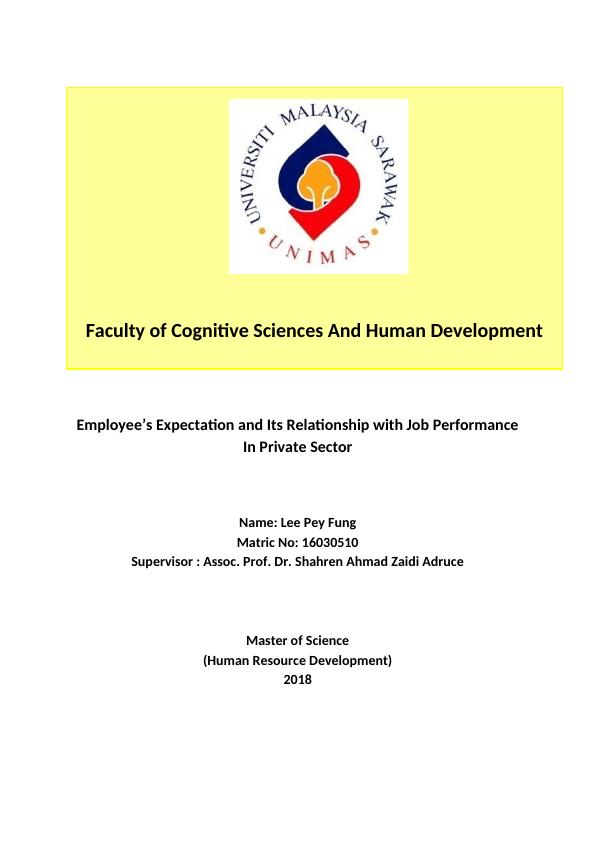
Acknowledgement
Thank you to all of those who have helped listened and encouraged me throughout this study.
I am indebted to my supervisor ......................... whose guidance, advice and patience
have been immeasurable. My sincere thanks to all members of the............... [Mention your
university/college name], both staff and students, whose continuous support have made this
thesis possible.
I would like to thank all of the participants in the study: students, teachers and Local
Education Authorities, for the time and help given throughout. Without their participation,
this research would not have been possible. In this context, I am also thankful to them, whose
research work helped me to execute this paper well.
Finally, I thank my family, without whom this thesis would not have been started or
completed! Your encouragement and support have never faltered; thank you.
Thank you to all of those who have helped listened and encouraged me throughout this study.
I am indebted to my supervisor ......................... whose guidance, advice and patience
have been immeasurable. My sincere thanks to all members of the............... [Mention your
university/college name], both staff and students, whose continuous support have made this
thesis possible.
I would like to thank all of the participants in the study: students, teachers and Local
Education Authorities, for the time and help given throughout. Without their participation,
this research would not have been possible. In this context, I am also thankful to them, whose
research work helped me to execute this paper well.
Finally, I thank my family, without whom this thesis would not have been started or
completed! Your encouragement and support have never faltered; thank you.
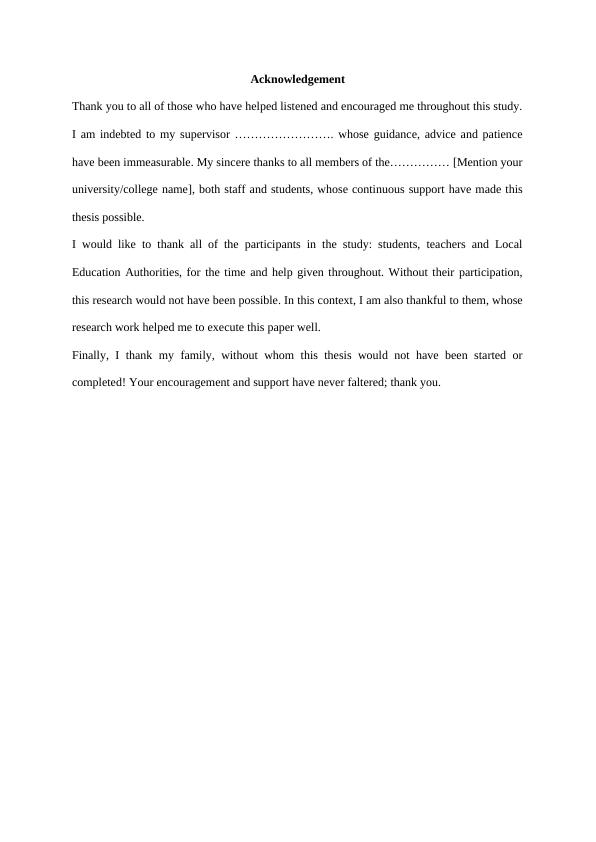
Table of Contents
Chapter 1....................................................................................................................................3
INTRODUCTION.....................................................................................................................3
1.1 INTRODUCTION.......................................................................................................3
1.2 BACKGROUND OF THE STUDY............................................................................3
1.3 PPROBLEM STATEMENT.......................................................................................4
1.4 OBJECTIVE OF STUDY...........................................................................................5
1.4.1 General Objective................................................................................................5
1.4.2 Specific Objectives..............................................................................................6
1.5 RESEARCH QUESTION...........................................................................................6
1.6 RESEARCH HYPOTHESIS.......................................................................................6
1.7 CONCEPTUAL FRAMEWORK................................................................................6
1.8 SIGNIFICANT OF THE STUDY...............................................................................7
1.8.1 Significance to Organization................................................................................7
1.8.2 Significance to Employees...................................................................................8
1.8.3 Significance to the Research Methodology.........................................................8
1.9 LIMITATION OF THE STUDY................................................................................8
1.10 DEFINITION OF TERM............................................................................................9
1.10.1 Job Expectation....................................................................................................9
1.10.2 Job performance...................................................................................................9
1.10.3 Remuneration.......................................................................................................9
Chapter 1....................................................................................................................................3
INTRODUCTION.....................................................................................................................3
1.1 INTRODUCTION.......................................................................................................3
1.2 BACKGROUND OF THE STUDY............................................................................3
1.3 PPROBLEM STATEMENT.......................................................................................4
1.4 OBJECTIVE OF STUDY...........................................................................................5
1.4.1 General Objective................................................................................................5
1.4.2 Specific Objectives..............................................................................................6
1.5 RESEARCH QUESTION...........................................................................................6
1.6 RESEARCH HYPOTHESIS.......................................................................................6
1.7 CONCEPTUAL FRAMEWORK................................................................................6
1.8 SIGNIFICANT OF THE STUDY...............................................................................7
1.8.1 Significance to Organization................................................................................7
1.8.2 Significance to Employees...................................................................................8
1.8.3 Significance to the Research Methodology.........................................................8
1.9 LIMITATION OF THE STUDY................................................................................8
1.10 DEFINITION OF TERM............................................................................................9
1.10.1 Job Expectation....................................................................................................9
1.10.2 Job performance...................................................................................................9
1.10.3 Remuneration.......................................................................................................9

1.10.4 Work Environment............................................................................................10
1.10.5 Organisation Culture.........................................................................................10
1.11 SUMMARY...........................................................................................................11
CHAPTER 2............................................................................................................................11
LITERATURE REVIEW........................................................................................................11
2.1 INTRODUCTION.....................................................................................................11
2.2 Discussion of issues related to topic..........................................................................11
2.2.1 Issues related to employee expectation and job performance in private sector.......11
2.3 Discussion of related theory/model...........................................................................12
2.3.1 The Maslow’s Hierarchy of Needs Theory.............................................................13
2.3.2 Herzberg’s Two-Factor Theory of Motivation........................................................15
2.4 Discussion of past similar findings...........................................................................16
2.4.1 Difference between gender & Job performance......................................................16
2.4.2 Difference between age & job performance............................................................16
2.4.3 Relationship between remuneration and Job performance......................................17
2.3.4 Relationship between work environment and job performance..............................17
2.3.5 Relationship between organisation culture and job performance............................18
2.4 SUMMARY..............................................................................................................18
CHAPTER 3............................................................................................................................19
RESEARCH METHODOLOGY.............................................................................................19
3.1 INTRODUCTION..........................................................................................................19
1.10.5 Organisation Culture.........................................................................................10
1.11 SUMMARY...........................................................................................................11
CHAPTER 2............................................................................................................................11
LITERATURE REVIEW........................................................................................................11
2.1 INTRODUCTION.....................................................................................................11
2.2 Discussion of issues related to topic..........................................................................11
2.2.1 Issues related to employee expectation and job performance in private sector.......11
2.3 Discussion of related theory/model...........................................................................12
2.3.1 The Maslow’s Hierarchy of Needs Theory.............................................................13
2.3.2 Herzberg’s Two-Factor Theory of Motivation........................................................15
2.4 Discussion of past similar findings...........................................................................16
2.4.1 Difference between gender & Job performance......................................................16
2.4.2 Difference between age & job performance............................................................16
2.4.3 Relationship between remuneration and Job performance......................................17
2.3.4 Relationship between work environment and job performance..............................17
2.3.5 Relationship between organisation culture and job performance............................18
2.4 SUMMARY..............................................................................................................18
CHAPTER 3............................................................................................................................19
RESEARCH METHODOLOGY.............................................................................................19
3.1 INTRODUCTION..........................................................................................................19
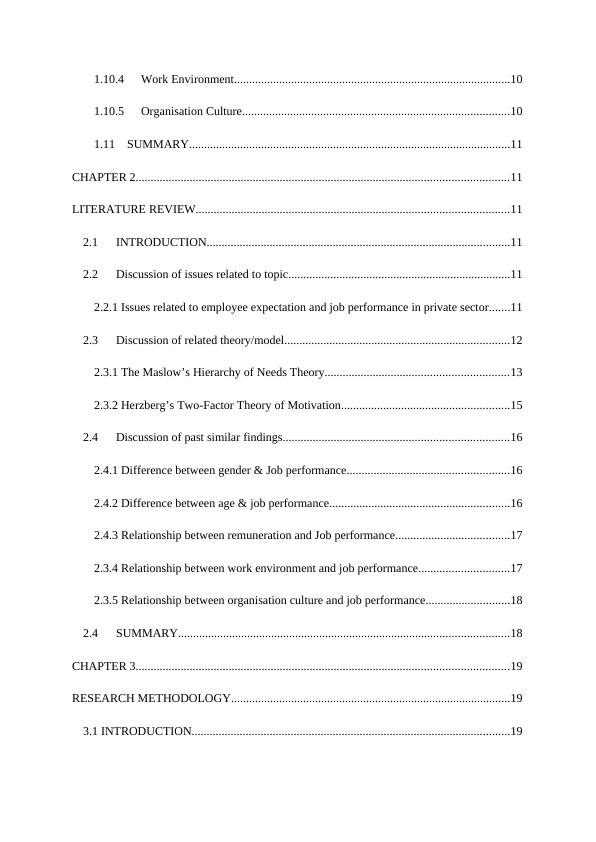
3.2 RESEARCH DESIGN...................................................................................................19
3.3 LOCATION OF STUDY...............................................................................................20
3.4 POPULATION AND SAMPLES..................................................................................20
3.5 RESEARCH INSTRUMENTS......................................................................................21
3.5.1 Section A: Demography.....................................................................................21
3.5.2 Section B: Employee’s Expectation...................................................................21
3.5.3 Section C: Employee’s Job Performance...........................................................22
3.6 RELIABILITY TEST.....................................................................................................22
3.7 VALIDITY TEST.....................................................................................................22
3.8 ETHICS OF THE STUDY.............................................................................................23
3.9 DATA COLLECTION METHOD............................................................................23
3.9.1 Primary Data............................................................................................................23
3.9.2 Secondary Data........................................................................................................23
3.10 DATA ANALYSIS......................................................................................................24
3.10.1. Descriptive Statistics............................................................................................24
3.10.2. Inferential Statistics..............................................................................................24
3.11 SUMMARY..............................................................................................................26
Chapter 4..................................................................................................................................27
DATA ANALYSIS..................................................................................................................27
4.1 Demographic Background of the Respondents..............................................................27
4.1.1 Gender Characteristics................................................................................................29
3.3 LOCATION OF STUDY...............................................................................................20
3.4 POPULATION AND SAMPLES..................................................................................20
3.5 RESEARCH INSTRUMENTS......................................................................................21
3.5.1 Section A: Demography.....................................................................................21
3.5.2 Section B: Employee’s Expectation...................................................................21
3.5.3 Section C: Employee’s Job Performance...........................................................22
3.6 RELIABILITY TEST.....................................................................................................22
3.7 VALIDITY TEST.....................................................................................................22
3.8 ETHICS OF THE STUDY.............................................................................................23
3.9 DATA COLLECTION METHOD............................................................................23
3.9.1 Primary Data............................................................................................................23
3.9.2 Secondary Data........................................................................................................23
3.10 DATA ANALYSIS......................................................................................................24
3.10.1. Descriptive Statistics............................................................................................24
3.10.2. Inferential Statistics..............................................................................................24
3.11 SUMMARY..............................................................................................................26
Chapter 4..................................................................................................................................27
DATA ANALYSIS..................................................................................................................27
4.1 Demographic Background of the Respondents..............................................................27
4.1.1 Gender Characteristics................................................................................................29

4.1.2 Marital Status..............................................................................................................30
4.1.3 Ethnicity......................................................................................................................31
4.1.4 Age..............................................................................................................................31
4.1.5 Higher Education Level...............................................................................................32
4.1.6 Monthly Salary............................................................................................................33
4.1.7 Length of Service........................................................................................................34
4.2 Univariate Analysis........................................................................................................34
4.2.1 RQ1: What is the level of employees’ job performance in the organization?............34
4.2.2 RQ2: What is the level of employees’ job expectations in the organisation?...............35
4.2.3 Hypothesis testing using Independent t-test................................................................36
4.2.4 Hypothesis Testing Using One-Way ANOVA Test....................................................37
4.2.5 Using Pearson Correlation Coefficient Test to test Hypothesis..................................40
4.3 Summary of the Research Findings................................................................................44
4.4 Chapter Summary...........................................................................................................45
CHAPTER 5............................................................................................................................46
CONCLUSION........................................................................................................................46
5.1 Introduction....................................................................................................................46
5.2 Summary of the Study....................................................................................................46
5.3 Discussion of the Research Findings..............................................................................47
5.3.1 H01 There is no Significant Difference in Employees’ Job Performance Based on
Gender 47
4.1.3 Ethnicity......................................................................................................................31
4.1.4 Age..............................................................................................................................31
4.1.5 Higher Education Level...............................................................................................32
4.1.6 Monthly Salary............................................................................................................33
4.1.7 Length of Service........................................................................................................34
4.2 Univariate Analysis........................................................................................................34
4.2.1 RQ1: What is the level of employees’ job performance in the organization?............34
4.2.2 RQ2: What is the level of employees’ job expectations in the organisation?...............35
4.2.3 Hypothesis testing using Independent t-test................................................................36
4.2.4 Hypothesis Testing Using One-Way ANOVA Test....................................................37
4.2.5 Using Pearson Correlation Coefficient Test to test Hypothesis..................................40
4.3 Summary of the Research Findings................................................................................44
4.4 Chapter Summary...........................................................................................................45
CHAPTER 5............................................................................................................................46
CONCLUSION........................................................................................................................46
5.1 Introduction....................................................................................................................46
5.2 Summary of the Study....................................................................................................46
5.3 Discussion of the Research Findings..............................................................................47
5.3.1 H01 There is no Significant Difference in Employees’ Job Performance Based on
Gender 47
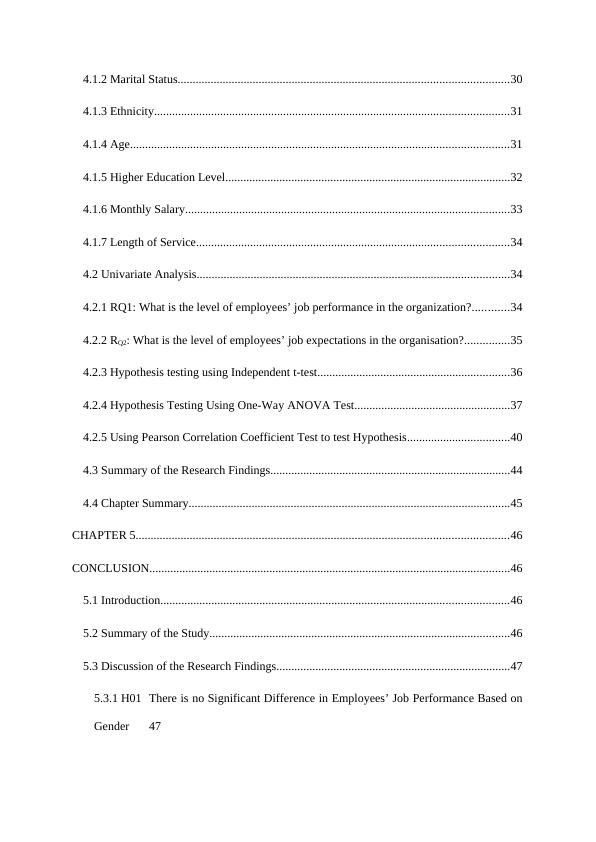
5.3.2 H02 There is no Significant Difference in Employees’ Job Performance Based on
Age 47
5.3.3 H03 There is no Relationship in between Remuneration and Employees’ Job
Performance......................................................................................................................48
5.3.4 H04 There is no Relationship in between Work Environment and Employees’ Job
Performance......................................................................................................................48
5.3.5 H04 There is no Relationship in between Organizational Culture and Employees’
Job Performance...................................................................................................................48
5.4 Summary of Discussion on Research Findings..............................................................49
5.5 Research Implications....................................................................................................50
5.5.1 Implication on the Applied Theory..........................................................................50
5.5.2 Future Researcher and Methodology..........................................................................50
5.3.3 Practitioners of Human Resource............................................................................50
5.5.4 Organization................................................................................................................51
5.5.5 Policy...........................................................................................................................51
5.6 Research Limitation.......................................................................................................51
5.7 Recommendations fromthis study..................................................................................52
5.7.1 Recommendation for Future Researchers................................................................52
5.7.2 Recommendations to Human Resource Practitioners..............................................52
5.7.3 Recommendations for Organizations......................................................................52
5.8 Conclusion......................................................................................................................53
REFERENCES.........................................................................................................................53
Age 47
5.3.3 H03 There is no Relationship in between Remuneration and Employees’ Job
Performance......................................................................................................................48
5.3.4 H04 There is no Relationship in between Work Environment and Employees’ Job
Performance......................................................................................................................48
5.3.5 H04 There is no Relationship in between Organizational Culture and Employees’
Job Performance...................................................................................................................48
5.4 Summary of Discussion on Research Findings..............................................................49
5.5 Research Implications....................................................................................................50
5.5.1 Implication on the Applied Theory..........................................................................50
5.5.2 Future Researcher and Methodology..........................................................................50
5.3.3 Practitioners of Human Resource............................................................................50
5.5.4 Organization................................................................................................................51
5.5.5 Policy...........................................................................................................................51
5.6 Research Limitation.......................................................................................................51
5.7 Recommendations fromthis study..................................................................................52
5.7.1 Recommendation for Future Researchers................................................................52
5.7.2 Recommendations to Human Resource Practitioners..............................................52
5.7.3 Recommendations for Organizations......................................................................52
5.8 Conclusion......................................................................................................................53
REFERENCES.........................................................................................................................53
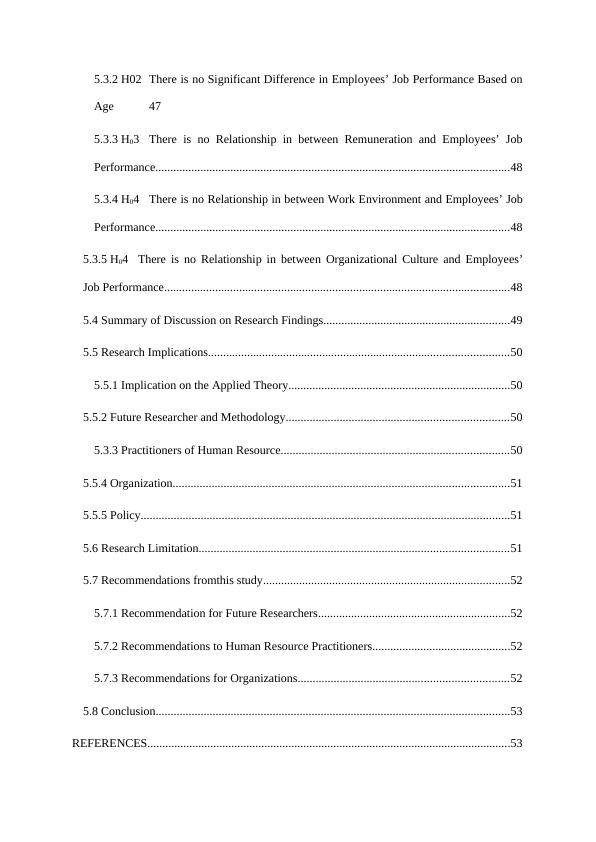
APPENDIX A..........................................................................................................................60
List of figures
Figure 1.1 : Conceptual framework.........................................................................................12
Figure 1: Maslow’s Hierarchy of needs...................................................................................19
Figure 3.4.1 : Calculation of minimum sample size................................................................26
Figure 1: Gender characteristics of the respondents................................................................35
Figure 2: Marital status of the respondents..............................................................................36
Figure 3: Ethnic background....................................................................................................36
Figure 4: Age...........................................................................................................................37
Figure 5: Higher education level..............................................................................................38
Figure 6: Monthly salary level.................................................................................................39
Figure 7: Length of service......................................................................................................40
Figure 8: Level of job performance.........................................................................................41
List of tables
Table 3.10.1..............................................................................................................................30
Table 3.8.2.1 : Data analysis framework.................................................................................31
Table 7 Calculations.................................................................................................................34
Table 8: Statistics of univariate analysis..................................................................................40
Table 9: Mean for each independent variable..........................................................................41
Table 10: Mean and standard deviation of employees based on Gender.................................42
Table 11: Independent sample t-test for employees based on gender......................................42
Table 12: Mean and standard deviation of employees based on age.......................................43
Table 13: Levene’s Test of Equality of Error Variances.........................................................43
List of figures
Figure 1.1 : Conceptual framework.........................................................................................12
Figure 1: Maslow’s Hierarchy of needs...................................................................................19
Figure 3.4.1 : Calculation of minimum sample size................................................................26
Figure 1: Gender characteristics of the respondents................................................................35
Figure 2: Marital status of the respondents..............................................................................36
Figure 3: Ethnic background....................................................................................................36
Figure 4: Age...........................................................................................................................37
Figure 5: Higher education level..............................................................................................38
Figure 6: Monthly salary level.................................................................................................39
Figure 7: Length of service......................................................................................................40
Figure 8: Level of job performance.........................................................................................41
List of tables
Table 3.10.1..............................................................................................................................30
Table 3.8.2.1 : Data analysis framework.................................................................................31
Table 7 Calculations.................................................................................................................34
Table 8: Statistics of univariate analysis..................................................................................40
Table 9: Mean for each independent variable..........................................................................41
Table 10: Mean and standard deviation of employees based on Gender.................................42
Table 11: Independent sample t-test for employees based on gender......................................42
Table 12: Mean and standard deviation of employees based on age.......................................43
Table 13: Levene’s Test of Equality of Error Variances.........................................................43
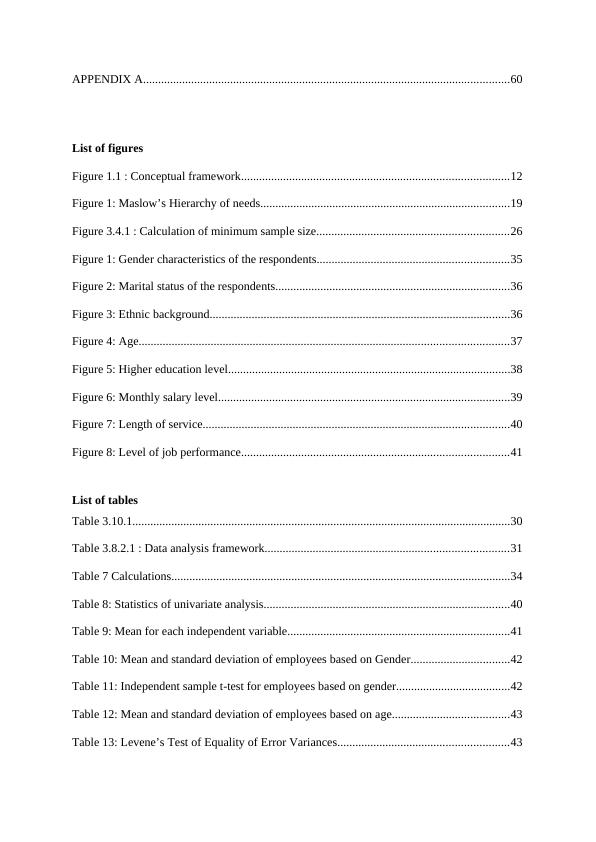
End of preview
Want to access all the pages? Upload your documents or become a member.
Related Documents
Employee’s Expectation and Its Relationship with Job Performance in Private Sectorlg...
|39
|8499
|295
Asia Pacific Management Reviewlg...
|79
|17932
|28
Modern and Traditional teaching Methods assignment pdflg...
|31
|11283
|332
Partnership Relationship Between Manufacturer and Distributor in Eastern Green Marketinglg...
|108
|14200
|99
Effective Leadership Style in Marketing Start-uplg...
|64
|9822
|184
Third Party Logistic outsourcing on the performance of FMCG companylg...
|55
|18190
|45
